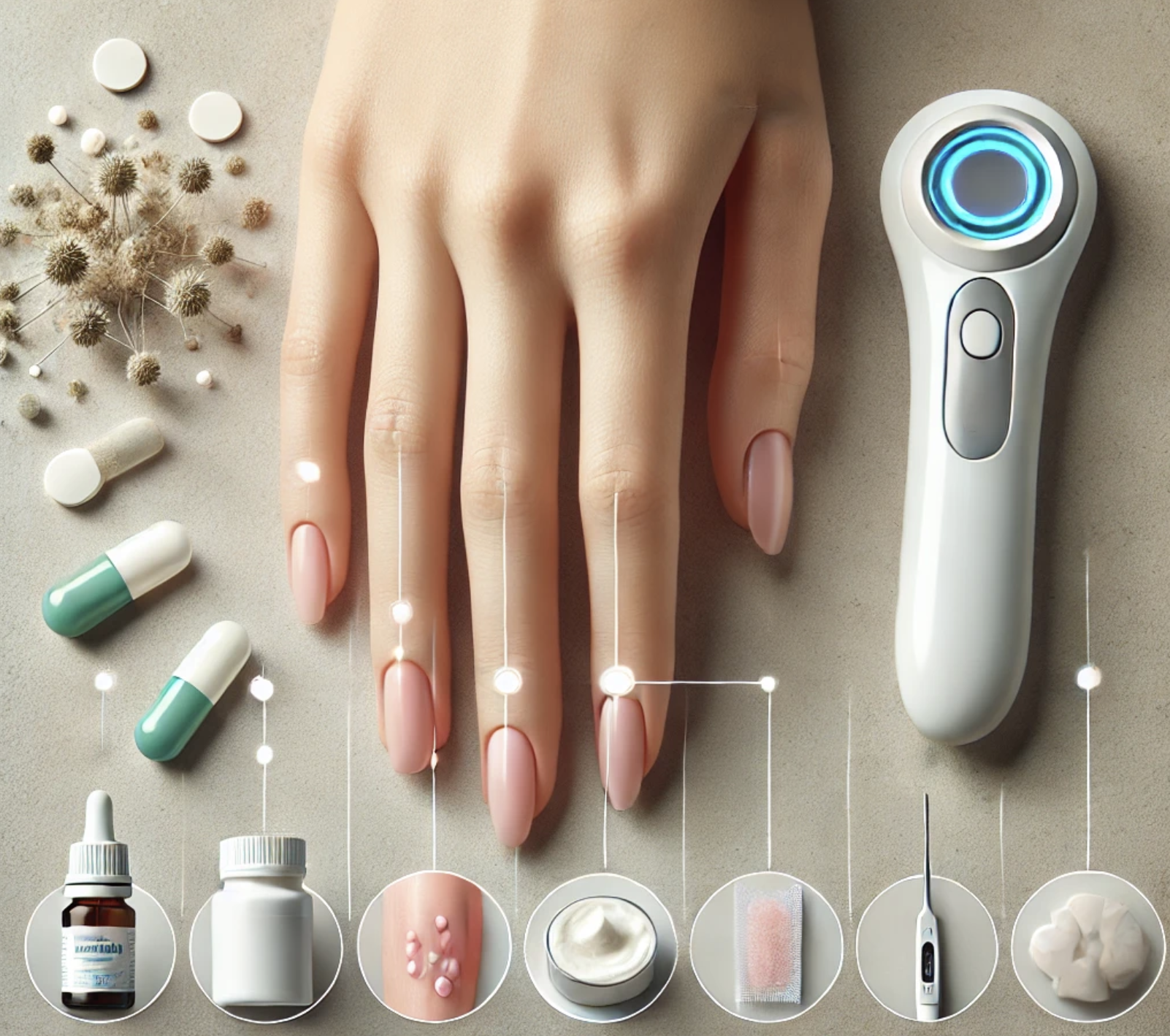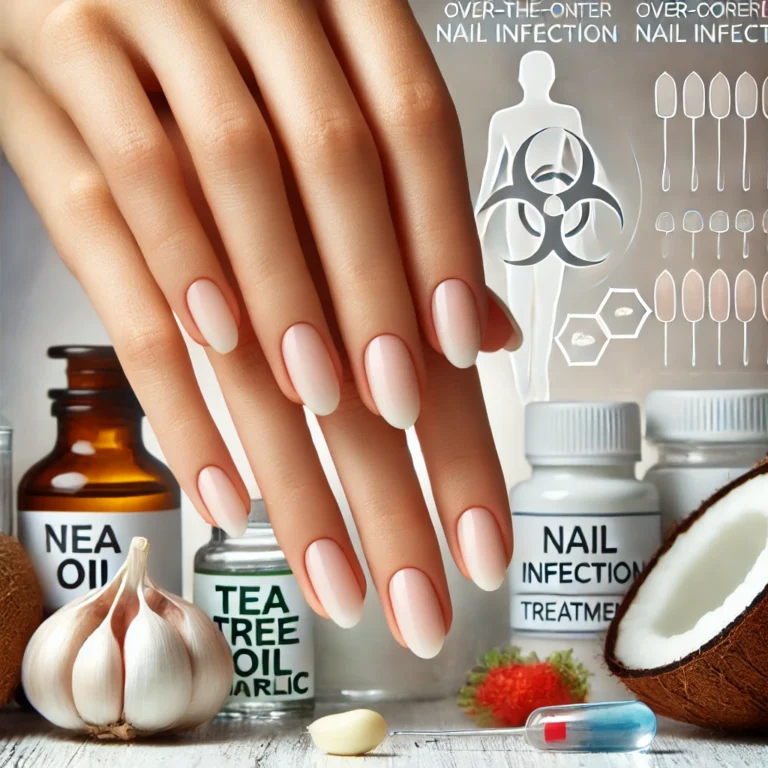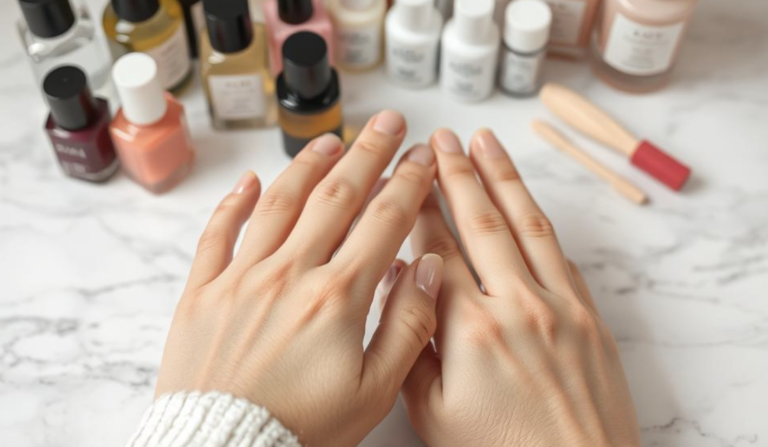The Definitive Ranking of Fungal Nail Treatments (Based on Clinical Studies)
Fungal nail infections, also known as onychomycosis, are a common but often overlooked problem that affects millions of people worldwide. These infections can occur in both toenails and fingernails, leading to symptoms such as discoloration, thickening, crumbling, and sometimes, pain. While the infection is not typically dangerous, it can significantly affect your nail’s appearance and health, causing discomfort and embarrassment.
The causes of fungal nail infections are diverse, with fungi like Trichophyton rubrum and Candida albicans being the most common culprits. Factors such as poor foot hygiene, diabetes, a weakened immune system, and even wearing tight shoes or walking barefoot in public places like pools or gyms can increase the risk of developing a fungal infection.
If left untreated, fungal nail infections can worsen, spreading to other nails or even affecting the skin. That’s why early treatment is essential. Thankfully, there are a variety of treatments available, ranging from over-the-counter creams and oral medications to more advanced options like laser therapy. However, the effectiveness of these treatments can vary widely, which is why it’s crucial to understand the clinical evidence behind each option.
In this comprehensive guide, we’ll explore the top fungal nail treatments based on clinical studies, rank their effectiveness, and discuss the pros and cons of each method. Whether you’re dealing with a mild infection or a more stubborn case, this post will help you make an informed decision on the best course of action for treating your fungal nails.
Introduction to Fungal Nail Infections
What are fungal nail infections?
Fungal nail infections, also known as onychomycosis, are a common condition in which fungi infect one or more nails, causing them to become discolored, thickened, and often brittle. These infections can affect both toenails and fingernails but are more commonly seen in toenails due to the warm, moist environment inside shoes. While the infection is rarely dangerous, it can lead to significant cosmetic concerns, discomfort, and potential complications if left untreated.
Definition of onychomycosis
Onychomycosis refers specifically to a fungal infection of the nails, typically caused by dermatophytes, yeasts, or molds. This condition is not only unsightly but can also cause the nail to separate from the nail bed, which may result in pain or difficulty walking. The infection can spread, and untreated cases can lead to more severe health issues, particularly in individuals with compromised immune systems.
Common types of fungi involved
The most common fungi responsible for onychomycosis are:
-
Trichophyton rubrum: This dermatophyte is the primary cause of fungal nail infections, particularly in toenails. It thrives in warm, moist environments, making the feet a common site of infection.
-
Candida albicans: A type of yeast, Candida can infect fingernails and is often associated with people who have compromised immune systems or who frequently have their hands in water.
-
Trichophyton mentagrophytes: Another dermatophyte, though less common, it is also responsible for some cases of onychomycosis, especially in individuals with poor hygiene or who frequently engage in activities that expose the nails to moisture.
Symptoms of fungal nail infections
Fungal nail infections can manifest in various ways, but the most common symptoms include:
-
Discoloration: The affected nail may turn white, yellow, brown, or black, with the color changing over time.
-
Thickening: The nail may become thicker and harder to trim or maintain, often causing discomfort.
-
Crumbling: The nail may begin to crumble or break apart, especially at the edges, which can lead to further damage and potential infections.
-
Odor: In some cases, an unpleasant smell may develop due to the fungal growth.
-
Separation from the nail bed: The nail may separate from the underlying nail bed, which can cause pain and increase the risk of secondary bacterial infections.
How fungal infections spread
Fungal nail infections are highly contagious and can spread through direct or indirect contact with the infected area. They thrive in warm, damp environments, which makes communal spaces like swimming pools, gyms, and showers prime breeding grounds for the fungi. The infection can spread from one nail to another or even to other people if precautions aren’t taken.
-
Direct contact: Coming into direct contact with an infected nail or the surrounding skin.
-
Indirect contact: Walking barefoot in public areas or sharing personal items like towels, shoes, or nail clippers.
Risk factors
Several factors can increase the likelihood of developing a fungal nail infection, including:
-
Diabetes: People with diabetes are at a higher risk due to reduced circulation and a weakened immune system, which makes it harder to fight off infections.
-
Poor circulation: Conditions that affect blood flow, such as peripheral vascular disease, can hinder the body’s ability to fight off fungal infections.
-
Athlete’s foot: Fungal infections of the skin, like athlete’s foot, can easily spread to the nails if proper hygiene is not followed.
-
Nail injuries: Trauma to the nails, such as bruises or breaks, can provide an entry point for fungi.
-
Age: Older adults tend to have more brittle nails and compromised circulation, increasing the risk of onychomycosis.
-
Weakened immune system: Those with weakened immune systems, such as individuals with HIV/AIDS or cancer, are more susceptible to fungal infections.
Importance of early treatment
If left untreated, fungal nail infections can worsen and spread to other nails, leading to more serious complications. Early treatment is crucial to:
-
Prevent the spread: Treating fungal infections early helps stop them from spreading to other nails or people.
-
Avoid worsening of the infection: The infection can worsen over time, making treatment more difficult and potentially causing permanent damage to the nail.
-
Relieve discomfort: As the infection progresses, symptoms such as thickening, crumbling, and pain may become more pronounced, causing daily discomfort.
Overview of treatment options
There are several approaches to treating fungal nail infections, and the most effective method depends on the severity of the infection, the type of fungus involved, and the individual’s overall health.
-
Prescription treatments: Oral antifungal medications, such as Terbinafine and Itraconazole, are often prescribed for more severe infections. These treatments work by targeting the fungus from within the body and can have a higher success rate, especially for infections that don’t respond to topical treatments.
-
Over-the-counter treatments: Topical antifungal creams, lacquers, and ointments (like Ciclopirox and Efinaconazole) are available for treating mild to moderate fungal nail infections. These can be effective for some cases, though they generally take longer to show results.
-
Laser therapy: A newer treatment option, laser therapy uses focused light to target and destroy the fungi in the nail without causing damage to surrounding tissue.
-
Natural remedies: Some people turn to natural remedies like tea tree oil, vinegar, or garlic, though their effectiveness is debated and may not be sufficient for more severe cases.
In the next sections, we will explore these treatment options in greater detail and discuss their effectiveness based on clinical studies.
Types of Fungal Nail Treatments
Fungal nail infections can be treated in several ways, depending on the severity of the infection and the specific needs of the individual. From oral medications and topical treatments to advanced options like laser therapy, it’s essential to choose the right treatment based on clinical evidence, efficacy, and side effects. Below, we explore the most common treatment options available.
Oral Antifungal Medications
Oral antifungal medications are often prescribed for more severe cases of fungal nail infections. These medications work from within the body to eliminate the fungus and are generally more effective than topical treatments, especially for infections that have penetrated deep into the nail or surrounding tissue.
-
Examples:
-
Terbinafine: This is one of the most commonly prescribed oral antifungal drugs. It works by inhibiting the fungal cell membrane synthesis, stopping the growth of the fungus. Clinical studies show that Terbinafine has a high cure rate, particularly for toenail infections.
-
Itraconazole: Another commonly prescribed oral antifungal, Itraconazole interferes with the cell membrane of the fungi. It’s especially effective against both dermatophytes and yeasts.
-
Fluconazole: This medication is typically used for yeast-related fungal infections, such as those caused by Candida albicans. It has a broad spectrum of activity but may not be as effective for dermatophyte infections.
-
-
Pros:
-
High success rates for treating severe infections, especially toenail fungus.
-
Works from within the body, targeting deep infections that topical treatments might not reach.
-
Faster results in many cases compared to topical treatments.
-
-
Cons:
-
Potential side effects, such as liver damage, gastrointestinal issues, and skin rashes.
-
Requires long treatment durations (typically 6-12 weeks), and relapses can occur.
-
Not suitable for everyone, especially those with liver disease or weakened immune systems.
-
Clinical studies show that Terbinafine tends to be more effective than Itraconazole and Fluconazole, but the choice of medication depends on the patient’s health profile and the type of fungal infection.
Topical Antifungal Treatments
Topical treatments are applied directly to the affected nails and are generally used for mild to moderate cases of fungal infections. These treatments come in the form of creams, lacquers, or solutions that are applied to the nail’s surface.
-
Examples:
-
Ciclopirox: A topical antifungal lacquer that is applied to the nail. It works by disrupting the cell membrane of the fungus, preventing it from growing. Clinical studies show it is effective, especially when used consistently over a period of time.
-
Efinaconazole: A newer topical antifungal solution that is applied directly to the nail. It is specifically designed to penetrate the nail plate and target the fungus. Studies have shown it to be effective for treating mild to moderate onychomycosis, with minimal side effects.
-
-
How they work on the nails:
-
Topical treatments like Ciclopirox and Efinaconazole work by penetrating the nail plate and reaching the infected area beneath the nail. They disrupt the fungus’s cell membranes, preventing its growth and reproduction.
-
These treatments typically require consistent application for several months to achieve the desired results. The nail needs to be trimmed regularly to allow the medication to reach the affected area.
-
-
Pros:
-
Less invasive and fewer systemic side effects compared to oral medications.
-
Easier to use, especially for people with mild infections or those who cannot take oral antifungals.
-
Minimal side effects, with skin irritation being the most common.
-
-
Cons:
-
Slower to show results, especially for thicker nails or more severe infections.
-
Can be less effective in advanced cases or when the fungus has penetrated deep into the nail bed.
-
Laser Therapy for Nail Fungus
Laser therapy is a newer treatment for fungal nail infections. This technique uses focused light to target and destroy the fungi embedded in the nail without harming the surrounding tissue. Laser therapy is becoming an increasingly popular option due to its convenience and relatively non-invasive nature.
-
Efficacy and clinical study results:
-
Studies on laser therapy have shown promising results, with many patients experiencing significant improvements or even complete resolution of their infection after a few treatments.
-
The laser works by emitting light that penetrates the nail and destroys the fungal cells, disrupting their ability to reproduce.
-
While effective, laser therapy can be costly, and multiple sessions are often required for full results.
-
-
Pros:
-
Non-invasive and generally pain-free.
-
No need for oral medications or topical applications.
-
Clinically shown to be effective for many patients, especially when combined with other treatments.
-
-
Cons:
-
Expensive, and often not covered by insurance.
-
Multiple treatments may be required for optimal results.
-
Still considered a newer treatment, and long-term effectiveness is still being studied.
-
Natural Remedies for Fungal Nails
Some people prefer to use natural remedies for treating fungal nail infections. While these remedies may not be as well-studied or effective as pharmaceutical treatments, they are popular due to their accessibility and perceived safety.
-
Examples:
-
Tea Tree Oil: Known for its antifungal and antibacterial properties, tea tree oil is one of the most commonly used natural treatments for fungal nails. It can be applied directly to the infected area and has been shown in some studies to help reduce fungal growth.
-
Vinegar: The acidity in vinegar is believed to create an inhospitable environment for fungi. Some people soak their nails in a vinegar solution to help combat the infection.
-
Garlic: Garlic contains allicin, which is thought to have antifungal properties. Some individuals crush garlic and apply it directly to the affected nail or use garlic oil as a topical treatment.
-
-
Pros:
-
Natural and easily accessible.
-
Minimal side effects compared to pharmaceutical treatments.
-
-
Cons:
-
Limited clinical evidence supporting their effectiveness.
-
May take a long time to show results, making them less suitable for severe infections.
-
Potential for skin irritation or allergic reactions in some individuals.
-
Surgical Treatments for Severe Infections
In rare cases, when other treatments have failed or the infection is severe, surgical intervention may be necessary. Surgical treatments for fungal nail infections typically involve the removal of the infected nail to allow for proper treatment of the nail bed.
-
When nail removal is necessary:
-
Severe or chronic infections: If a fungal infection has caused permanent damage to the nail and surrounding tissue, removal may be necessary to eliminate the infection completely.
-
Nail plate debridement: In cases where the nail has become thickened and damaged, removing part or all of the nail can help eliminate the fungus and allow the nail to regrow in a healthier state.
-
-
Pros:
-
Provides a permanent solution in extreme cases.
-
Can eliminate the infection when other treatments are ineffective.
-
-
Cons:
-
Surgical procedures come with the risk of infection, pain, and recovery time.
-
Removal of the nail may be traumatic, and there is a possibility of permanent nail deformities.
-
Clinical Studies on Fungal Nail Treatments
When it comes to treating fungal nail infections, clinical studies are essential to understanding the effectiveness and potential limitations of various treatments. From oral antifungals to topical creams, laser therapy, and even natural remedies, it’s crucial to know which treatments have been backed by research and which may fall short. This section delves into the results of key clinical studies on the most popular treatments for fungal nail infections.
Effectiveness of Oral Antifungal Drugs
Oral antifungal medications are often the go-to choice for treating moderate to severe fungal nail infections. Several studies have evaluated the effectiveness of oral antifungals like Terbinafine, Itraconazole, and Fluconazole. The results suggest that oral treatments tend to be more effective than topical treatments, especially for infections involving the toenails.
-
Key studies comparing Terbinafine and Itraconazole:
-
A landmark study published in The Lancet compared the effectiveness of Terbinafine and Itraconazole in treating fungal nail infections. The study found that Terbinafine had a significantly higher success rate, with up to 70% of patients experiencing complete or near-complete resolution of their infection. In contrast, Itraconazole had a success rate of around 40-50%.
-
Another study in JAMA Dermatology showed that Terbinafine’s cure rate was superior to Itraconazole in both toenail and fingernail infections. However, Itraconazole is still a preferred option for certain patients due to its broader spectrum of activity against both dermatophytes and yeasts.
-
-
Conclusion: Clinical evidence overwhelmingly supports Terbinafine as the most effective oral antifungal for onychomycosis, with a higher cure rate than Itraconazole and Fluconazole, although individual responses may vary.
Clinical Results of Topical Antifungal Treatments
Topical antifungal treatments are generally recommended for mild to moderate infections, and clinical studies have shown that they can be quite effective, especially for more localized fungal infections.
-
Success rates of Efinaconazole and Ciclopirox:
-
Efinaconazole, a newer topical treatment, was the subject of several clinical trials, including a large-scale study published in JAMA Dermatology. The results showed that Efinaconazole had a success rate of 15-20% for complete cure after 48 weeks of treatment, with a significant improvement in nail appearance and reduction of fungal presence.
-
Ciclopirox, another topical antifungal lacquer, has been studied extensively. In one study published in Clinical Therapeutics, Ciclopirox showed an effective cure rate of about 10-20% after one year of use. However, while effective, its success rate is generally lower than oral medications and may take longer to show results.
-
-
Conclusion: While both Efinaconazole and Ciclopirox can be effective, especially for mild to moderate cases, they generally require prolonged treatment and may not achieve the same level of success as oral antifungals like Terbinafine.
Laser Treatment Effectiveness
Laser therapy has emerged as an alternative to traditional antifungal medications, using targeted light to penetrate the nail and destroy fungal cells without damaging surrounding tissues. While relatively new, several clinical studies have examined its potential.
-
Studies on the success of laser therapy for onychomycosis:
-
A study published in the Journal of the American Academy of Dermatology analyzed the effectiveness of laser therapy in treating toenail onychomycosis. The study found that laser treatment achieved a success rate of about 60-80%, with improvements in nail appearance and fungal clearance in many patients after 2-3 treatments.
-
Another clinical trial in Lasers in Surgery and Medicine showed that laser therapy significantly improved symptoms in patients with resistant infections. However, the results varied, with some patients requiring additional treatments to maintain the improvement.
-
-
Conclusion: Laser therapy has shown promising results for treating fungal nails, especially for those who have not responded to other treatments. However, it is generally more effective when used in conjunction with other treatments and may require multiple sessions for optimal results.
Home Remedies: Fact vs. Fiction
While natural remedies like tea tree oil and vinegar are often touted as effective treatments for fungal nail infections, the clinical evidence supporting these claims is mixed.
-
What clinical studies say about tea tree oil and vinegar:
-
Tea Tree Oil: Several small studies have investigated the antifungal properties of tea tree oil, with promising results. A study published in Dermatology Times showed that tea tree oil exhibited mild antifungal effects, but the overall cure rate was low (around 10-15%). The oil may help reduce symptoms like inflammation and nail discoloration but is unlikely to completely clear the infection.
-
Vinegar: A review in Mycoses explored the use of vinegar (acetic acid) for fungal nail infections. The study concluded that while vinegar has mild antifungal properties, its effectiveness in treating onychomycosis is not supported by substantial clinical evidence. It may help prevent fungal growth in minor cases but is generally not a cure for more severe infections.
-
-
Conclusion: While tea tree oil and vinegar may offer some mild relief for fungal nail infections, they lack strong clinical evidence to support their use as primary treatments. They are best used in conjunction with more proven therapies like oral or topical antifungals.
Long-Term Effectiveness of Treatments
When considering treatment options for fungal nails, it’s important to look not just at short-term results, but also at long-term outcomes and the likelihood of relapse.
-
Relapse rates and the importance of follow-up care:
-
Clinical studies show that oral antifungal medications like Terbinafine have the lowest relapse rates, with about 10-20% of patients experiencing a recurrence of the infection within the first year after treatment. Follow-up care, such as regular monitoring and proper nail care, is essential to preventing reinfection.
-
Topical treatments, including Ciclopirox and Efinaconazole, have higher relapse rates, with some studies showing recurrence rates as high as 40-50% within a year after completing treatment. Prolonged use and follow-up treatments are often recommended.
-
Laser therapy, while effective for many, also faces challenges in long-term results. Recurrence rates can be high if fungal spores are not fully eradicated, and patients may need repeat treatments.
-
-
Conclusion: Long-term success depends on a combination of initial treatment effectiveness and ongoing preventive care. Oral antifungals generally offer the best long-term outcomes, but even with the most effective treatments, relapse is possible without proper follow-up care and lifestyle adjustments to reduce risk factors.
Ranking the Best Fungal Nail Treatments
With so many fungal nail treatments available, it can be challenging to decide which one is the best for your specific situation. This section ranks the top fungal nail treatments based on clinical evidence, effectiveness, and cost considerations, helping you make an informed choice.
Top-Ranked Oral Antifungal Treatments
Oral antifungal treatments are often considered the most effective option for treating severe or widespread fungal nail infections. Among these, Terbinafine and Itraconazole are the most commonly prescribed medications, and clinical evidence helps determine which one stands out.
-
Based on clinical evidence: Terbinafine vs. Itraconazole:
-
Terbinafine is often considered the gold standard for treating onychomycosis due to its high success rate. Studies have shown that Terbinafine achieves a 60-80% cure rate, with lasting results for most patients. It works by inhibiting the synthesis of ergosterol, a key component of the fungal cell membrane.
-
Itraconazole is another oral antifungal option with a lower success rate compared to Terbinafine. Clinical studies report a 40-60% success rate, and while it is effective for both dermatophytes and yeasts, its overall performance is less robust for treating nail infections. Itraconazole’s advantage is that it has a broader spectrum of activity, which makes it suitable for mixed fungal infections.
-
-
Conclusion: Terbinafine is the top-ranked oral antifungal for fungal nail infections, offering superior efficacy in clinical trials. Itraconazole may still be considered for cases where broader coverage is needed, but its lower cure rate makes it a secondary option for most patients.
Top Topical Antifungal Treatments
For patients with mild to moderate fungal nail infections, topical treatments are often preferred due to their lower risk of side effects. The two leading topical antifungal treatments are Efinaconazole and Ciclopirox.
-
Efinaconazole and Ciclopirox effectiveness in studies:
-
Efinaconazole is a relatively new topical solution that has demonstrated good results in clinical studies. In a study published in JAMA Dermatology, Efinaconazole showed a 15-20% cure rate after 48 weeks of use, with improved nail appearance and fungal reduction. Although it requires long-term use, its effectiveness makes it a top choice for treating onychomycosis, particularly for toenails.
-
Ciclopirox, available as a topical lacquer, has been in use for longer than Efinaconazole. A study in Clinical Therapeutics found that Ciclopirox had a 10-20% cure rate, which is effective for mild to moderate infections but not as successful as oral treatments. The lacquer formulation requires daily application for several months, and while it is effective, it may not work as quickly as oral medications.
-
-
Conclusion: Efinaconazole is the top-ranked topical antifungal, with studies showing a significant improvement in both appearance and fungal reduction. However, Ciclopirox remains a viable option for those seeking a topical solution, though its success rates are generally lower.
Laser Treatment: Is it Worth the Cost?
Laser treatment for fungal nails is a relatively new approach, and while it shows promise, it remains a costly option. Clinical trials have been mixed, but many patients and healthcare providers are considering laser therapy as a non-invasive alternative to traditional treatments.
-
Pros and cons based on clinical trials:
-
Pros: Laser therapy works by using targeted light to penetrate the nail and destroy the fungi underneath without harming surrounding tissue. Studies, such as those published in Lasers in Surgery and Medicine, have shown success rates of 60-80%, with many patients experiencing visible improvements after 2-3 treatments.
-
Cons: The biggest downside is the high cost—laser treatments are often not covered by insurance, and multiple sessions may be required for optimal results. Moreover, results can vary, and some patients may not experience complete fungal clearance, necessitating follow-up treatments. Long-term efficacy is still under investigation.
-
-
Conclusion: Laser treatment may be worth the cost for those who have not had success with oral or topical treatments. However, it is not a guaranteed solution and may require ongoing treatments. It’s best considered for persistent or severe cases of fungal nails.
Comparing Natural Remedies
Natural remedies like tea tree oil and vinegar are popular alternatives for those who prefer to avoid pharmaceutical treatments. But do these home remedies live up to their claims? Clinical evidence is limited, but let’s take a closer look.
-
Do remedies like tea tree oil live up to their claims?:
-
Tea Tree Oil: Several studies have shown that tea tree oil has mild antifungal properties. A small study in Dermatology Times suggested that it could help reduce symptoms like inflammation and nail discoloration, but it was less effective at completely clearing the infection. The overall cure rate from tea tree oil is generally low, around 10-15%, and it works best when used as part of a broader treatment plan.
-
Vinegar: Vinegar (acetic acid) is believed to create an acidic environment that prevents fungal growth. Some research, including a review in Mycoses, has suggested vinegar may help prevent the spread of fungi but does not have sufficient evidence to support its use as a primary treatment for onychomycosis.
-
-
Conclusion: While tea tree oil and vinegar may provide mild relief or support when used alongside other treatments, they should not be relied upon as primary treatments for fungal nail infections. Their clinical effectiveness is limited, and they are best used for minor cases or in combination with stronger therapies.
When to Consider Surgical Options
In cases of severe, chronic, or resistant fungal infections, surgical intervention may be necessary. This is typically a last resort when other treatments have failed to provide adequate results.
-
Severe cases and the clinical recommendation:
-
Surgical options include nail removal or debridement, which involves the physical removal of the infected nail. A clinical recommendation for surgery is usually considered when the infection has caused significant damage to the nail and surrounding tissue, leading to chronic pain or an inability to use antifungal treatments effectively.
-
In one study published in Dermatologic Surgery, nail removal showed a high success rate in clearing the infection, with nearly 80-90% of patients reporting improvement after the procedure. However, recovery can be painful, and there is the risk of permanent nail deformity.
-
-
Conclusion: Surgical options should be considered only for severe cases where other treatments have not worked. While effective, they come with risks such as pain, infection, and permanent nail damage. Surgery is typically recommended when the infection is particularly stubborn or has caused irreversible damage
Prevention and Long-Term Care for Fungal Nails
Fungal nail infections can be persistent and challenging to treat, but with proper prevention and long-term care, you can reduce the risk of recurrence. This section provides tips on how to prevent fungal nail infections, maintain healthy nails after treatment, and avoid reinfection in the future.
Preventing Fungal Nail Infections
The best way to avoid dealing with a fungal nail infection is to take proactive steps in your daily habits. Good hygiene and mindful footwear choices are key in reducing the risk of developing an infection in the first place.
-
Tips for hygiene and footwear to reduce risk:
-
Practice good foot hygiene: Wash your feet daily with soap and water, and make sure to dry them thoroughly, especially between the toes. Fungi thrive in moist environments, so keeping feet dry is crucial.
-
Wear breathable shoes: Opt for footwear made from breathable materials like leather or mesh to allow air circulation, preventing moisture buildup around the nails. Avoid wearing tight-fitting shoes that trap sweat.
-
Use antifungal powder or spray: If you’re prone to fungal infections or frequently wear closed-toed shoes, applying an antifungal powder or spray to your feet and inside shoes can help keep fungi at bay.
-
Wear socks that wick away moisture: Choose socks made from moisture-wicking materials like cotton or wool, and change them regularly if they become damp.
-
Avoid walking barefoot in communal areas: Public showers, swimming pools, and locker rooms are common places for fungal spores to spread. Always wear flip-flops or waterproof sandals in these areas to reduce exposure.
-
-
Conclusion: Good hygiene practices and careful attention to footwear are the first line of defense against fungal nail infections. Keeping your feet dry and wearing appropriate shoes is essential in preventing the growth of fungi.
Keeping Nails Healthy After Treatment
Once your fungal nail infection is treated, it’s important to maintain healthy nails and prevent reinfection. Proper nail care can go a long way in ensuring that your nails remain fungus-free.
-
Follow-up care to prevent recurrence:
-
Regular nail trimming: Keep your nails trimmed to reduce the risk of fungal reinfection. Trim nails straight across, and avoid cutting too short to prevent trauma that could make your nails more susceptible to fungi.
-
Use a nail file for thickened nails: After an infection, your nails may become thickened or deformed. Gently filing the surface can help maintain the appearance of the nail and prevent buildup of debris that could encourage fungal growth.
-
Avoid nail polish on infected nails: Nail polish and other nail products can trap moisture under the nail, which creates an environment conducive to fungal growth. Give your nails time to breathe and recover fully before applying any polish.
-
-
Lifestyle changes to avoid future infections:
-
Improve circulation: If you have poor circulation (common in people with diabetes), take steps to improve blood flow to your extremities. This may include exercises, wearing compression socks, or taking regular walks.
-
Manage underlying conditions: If you have risk factors like diabetes or immune system issues, managing these conditions properly can help lower the chances of developing fungal infections. Keep blood sugar levels in check and take any prescribed medications as directed by your doctor.
-
-
Conclusion: After treatment, maintaining healthy nails through proper care is essential to preventing reinfection. Regular trimming, filing, and moisture management are key to nail health.
How to Spot Early Signs of Reinfection
Even after successfully treating a fungal nail infection, there is always the possibility of reinfection. Being vigilant and monitoring your nails can help catch any early signs of reinfection, allowing for prompt intervention before the infection becomes severe again.
-
Monitoring your nails after treatment:
-
Keep an eye out for any discoloration, thickening, or crumbling of the nails, which are signs that the infection may be returning.
-
Flaking or peeling of the nail surface can also indicate fungal activity, especially if it is accompanied by discomfort or an unusual odor.
-
If you notice any of these changes, start antifungal treatment right away and consider consulting your healthcare provider for advice.
-
-
When to see a doctor for nail fungus:
-
Recognizing the signs of treatment failure or relapse: If you’ve noticed that your fungal nail infection is returning after treatment, it’s important to consult a doctor. Signs of relapse include persistent discoloration, nail thickening, or new symptoms after you’ve completed a course of treatment.
-
If you have severe pain, swelling, or pus around the infected area, it may indicate a secondary infection or complication that requires immediate medical attention.
-
-
Conclusion: Early detection of reinfection is essential to prevent the infection from worsening. Be proactive in monitoring your nails for any signs of recurrence, and seek medical attention promptly if necessary.







3 Comments